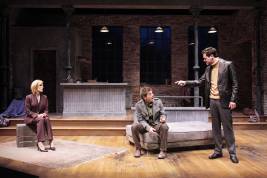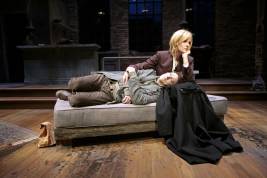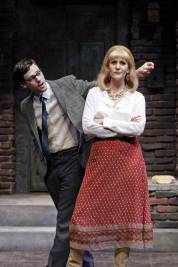
Tony-winning playwright Richard Greenberg might well have called his fourteenth play Sins Of The Fathers, so heavily do the sins (or at least the perceived sins) of Walker Janeway’s parents continue to weigh on the life of this angry young man in Three Days Of Rain, now getting a pitch-perfect revival at South Coast Repertory, the same theater that world premiered it in 1997.
At lights up, Walker (Kevin Rahm) has just returned to the land of the living, i.e. to New York City, having disappeared without a trace a year ago on the day his father Edmund “Ned” Janeway was buried. What has prompted Walker’s sudden reappearance in the life of his sister Nan (Susannah Schulman) and their childhood friend Pip (Brendan Hines) is today’s reading of Ned’s will, with not only the world renowned architect’s considerable fortune, but also the internationally famed and admired Janeway House, at stake.
The Ned Janeway that Walker describes to us in one of Three Days Of Rain’s numerous asides to the audience is hardly the sort of father a son could get close to. Walker paints the picture of a taciturn, affectionless man whose shadow still weighs heavily on his adult son. In a posthumous attempt to understand this “Daddy Dearest,” Walker has searched the loft where Janeway House was designed, and has come up with something that might provide a clue or two—his father’s journal. Unfortunately, all the journal appears to reveal is simply more proof that Ned was a man seemingly without a heart. For instance, of his design partner’s premature death, all Ned could manage to write was “January 3—Theo is dying. January 5—Theo is dying. January 18—Theo dead.” Even the journal’s first entry (“1960, April 3rd to April 5th—Three days of rain.”) comes across to Walker as nothing more than “a fucking weather report.”
Three Day’s Of Rain’s first act offers numerous surprises to both its characters and its audience, from the unexpected terms of Ned Janeway’s will to daytime soap star Pip’s past relationship with one if not both of the Janeway siblings. Even at its conclusion, however, Walker remains disturbed by the many mysteries of his parents’ lives, questions whose answers, for Walker at least, may never be found.
Audience members are considerably more fortunate, though, as Act Two takes us back to 1960, to the events which transpired before and during the pivotal “three days of rain” in the same loft where Walker, Nan, and Pip have come together thirty-five years later. As we get to know Ned Janeway (Rahm), his future wife Lina (Schulman), and Ned’s design partner (and Pip’s father) Theo (Hines), it gradually becomes clear how much of their lives their children have misunderstood, and more particularly, how very differently Ned viewed his journal entries from his son’s perceptions of them three and a half decades later.
At first viewing, Three Days Of Rain may seem like the first acts of two separate plays. In particular, time spent in Act One with Walker, Nan, and Pip leaves us longing for more. A second viewing (or at least some post-performance reflection) reveals, however, that Act Two exists precisely to provide answers to Act One’s questions, at least for those of us in the theater, if not for the still confused and conflicted Walker.
A bit of advice on how to enjoy Three Days Of Rain to its fullest. Listen carefully in Act One to what Walker, Nan, and Pip have to say about Ned, Lina, and Theo. Then, as you watch Act Two unfold, compare their children’s perceptions with what you get from “the horses’ mouths,” and you will likely see why Three Days Of Rain is considered one of playwright Greenberg’s great ones.
South Coast Rep Founding Artistic Director David Emmes has directed this fourteenth anniversary production with assurance and finesse, his three stars excelling at what end up being two very different performances each. The deft and charismatic Rahm’s ease with words as Walker contrasts dramatically with Ned’s verbal awkwardness. The always excellent Schulman, whose pair of wigs make her look like a blonde Julia Roberts (Nan and Lina in the Broadway revival), gives us a sane-and-stable Nan about as distinct from verge-of-madness Lina as imaginable. Hines’ two characters have less to differentiate them than his castmates’, but the talented actor proves to be more than just tall, dark, and handsome in his dynamic portrayal of both. All three stars combine stage presence and acting chops in equal measure, making the time we spend with them both thoroughly enjoyable and utterly fascinating.
Scenic designer Thomas Buderwitz has designed a superbly detailed downtown Manhattan loft, dilapidated in Act One and considerably brighter-looking in Act Two—and there is actual rain, or at least enough water falling from the rafters to drench the cast at appropriate moments. Holly Poe Durbin’s costumes are mostly spot-on 1995 and 1960 designs, with the exception of Lina’s first outfit, which looks like nothing I recall from the year JFK was elected President. Lonnie Rafael Alcaraz’s lighting design both focuses attention and ups the dramatic impact of key scenes. Sound designer (and current Tony award nominee) Cricket S. Myers gives us a vivid New York soundtrack, both musically and in the sounds which enter the loft from outside. Joshua Marchesi is production manager, Jamie A. Tucker stage manager.
Three Days Of Rain makes for a fascinatingly written and beautifully acted and directed conclusion to South Coast Repertory’s 47th season. Once again, Angelinos are encouraged to make the drive down to Costa Mesa to see some of the best regional theater this country has to offer. Just remember to keep your ears alert during Act One—and then let Act Two fill in the blanks—and you’ll have ample reason to applaud.
South Coast Repertory, 655 Town Center Drive, Costa Mesa.
www.scr.org
–Steven Stanley
May 24, 2011
Photos: Henry DiRocco





 Since 2007, Steven Stanley's StageSceneLA.com has spotlighted the best in Southern California theater via reviews, interviews, and its annual StageSceneLA Scenies.
Since 2007, Steven Stanley's StageSceneLA.com has spotlighted the best in Southern California theater via reviews, interviews, and its annual StageSceneLA Scenies.







 COPYRIGHT 2024 STEVEN STANLEY :: DESIGN BY
COPYRIGHT 2024 STEVEN STANLEY :: DESIGN BY